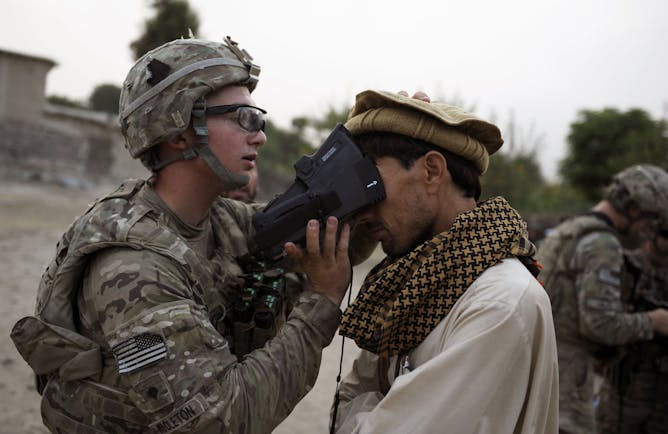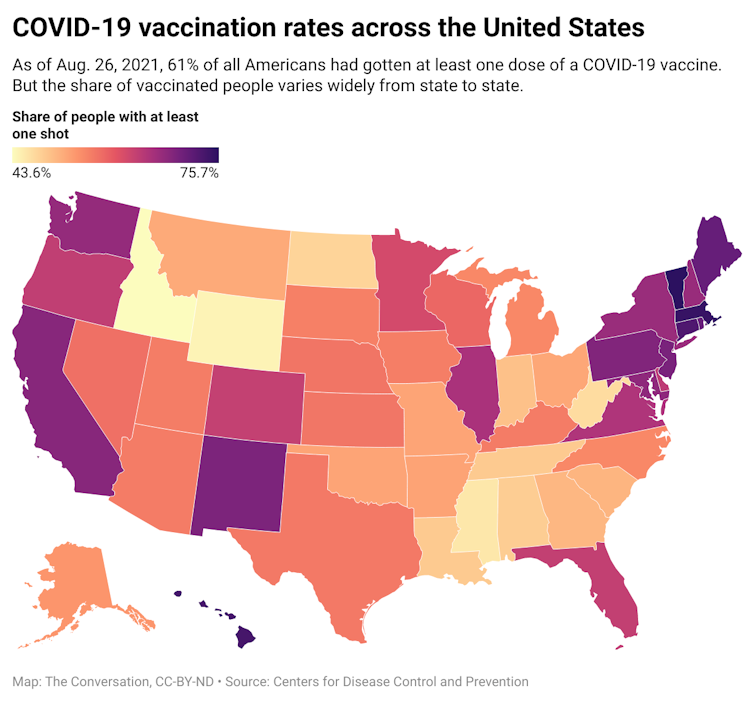|
|
|
|
The fall of the Afghan national government has put the lives of tens of thousands of Afghans who worked for U.S. and coalition forces at risk, with reports of detentions and executions stoking fears. As the deadline for the U.S. withdrawal on Aug. 31 neared, the U.S. said it has evacuated at least 117,000 people, the vast majority Afghans.
Although the Taliban signed a deal with 98 countries to continue to allow people to leave the country, many Afghans remain in jeopardy, including those who won’t have access to travel documents or won’t risk passing through Taliban checkpoints. For those left behind, the worry is whether and how the Taliban will try to track them down. Of particular concern are reports that the Taliban have possession of U.S. military biometric devices.
Penn State legal scholar Margaret Hu breaks down how those devices work, what information the military was collecting and who is at risk. She also underscores the larger lessons for securing information that can be used to identify and track people – a matter of life and death in conflict zones.
Also today:
|

|
Eric Smalley
Science + Technology Editor
|
|

A U.S. Army soldier scans the irises of an Afghan civilian in 2012 as part of an effort by the military to collect biometric information from much of the Afghan population.
Jose Cabezas/AFP via GettyImages
Margaret Hu, Penn State
The potential failure of the U.S. military to protect information that can identify Afghan citizens raises questions about whether and how biometric data should be collected in war zones.
|
Politics + Society
|
-
Christopher Robertson, Boston University; Wesley Oliver, Duquesne University
People who forge their own vaccine cards, or buy forged cards, are already facing legal problems, including criminal charges.
-
Mikkel Dack, Rowan University; Colleen Murphy, University of Illinois at Urbana-Champaign; Gary LaFree, University of Maryland; John Horgan, Georgia State University; Kurt Braddock, American University School of Communication; Monika Nalepa, University of Chicago
Addressing American domestic radicalism will require new ways of thinking about the nation’s problems, and new ways of solving them.
|
|
Environment + Energy
|
-
Stacy Morford, The Conversation
The New Orleans region is likely to see a hurricane about every seven years and a major hurricane about every 20.
-
Luke Montrose, Boise State University; Adam Schuller, Boise State University
Here are some of the ways wildfire smoke particles or the inflammatory signals they cause could reach the brain and what researchers found in the sperm of animals exposed to wildfire smoke.
|
|
Economy + Business
|
-
Katy Ramsey Mason, University of Memphis
A legal scholar explains background on the ruling, what it means and who’s affected.
|
|
Ethics + Religion
|
-
Melissa Schoenberger, College of the Holy Cross
The 2,000-line poem by Scottish physician John Armstrong was written during a time of pandemic, war and increasing public disinformation. What can readers learn from it today?
-
Helen A. Berger, Brandeis University
Interest in Wicca and witchcraft appears to be increasing, but what exactly is Wicca in the first place?
|
|
Science + Technology
|
-
Cason Schmit, Texas A&M University; Brian N. Larson, Texas A&M University; Hye-Chung Kum, Texas A&M University
Profit-friendly data privacy laws in the U.S. are out of step with public sentiment and hinder uses the public supports, from reducing opioid overdose deaths to curbing the COVID-19 pandemic.
-
Glenn J Rapsinski, University of Pittsburgh
An infectious disease doctor explains the science behind COVID-19 vaccines at a level that children – and adults – of all ages can understand.
|
|
Trending on Site
|
-
Amira Jadoon, United States Military Academy West Point; Andrew Mines, George Washington University
An attack on the Kabul airport has left scores dead and many more injured. Two terrorism scholars explain who the group thought responsible is, and how big of a threat is it.
-
Kristine Grayson, University of Richmond
Biological control strategies curb pests using other species that attack the invader. A biologist explains why it can take more than a decade to develop an effective biological control program.
-
Nadejda Williams, University of West Georgia
While they weren’t living through a pandemic, citizens of ancient Pompeii weren’t strangers to societal stress.
Today’s graphic

|
|
| |
| |
| |
| |

|
| |
| |
| |
| |
| |
| |
| |
| |
|
|
|
|
|
|
|